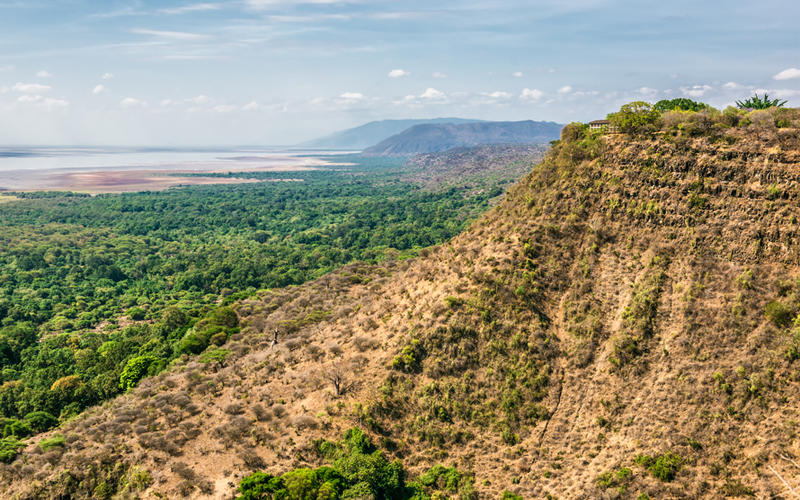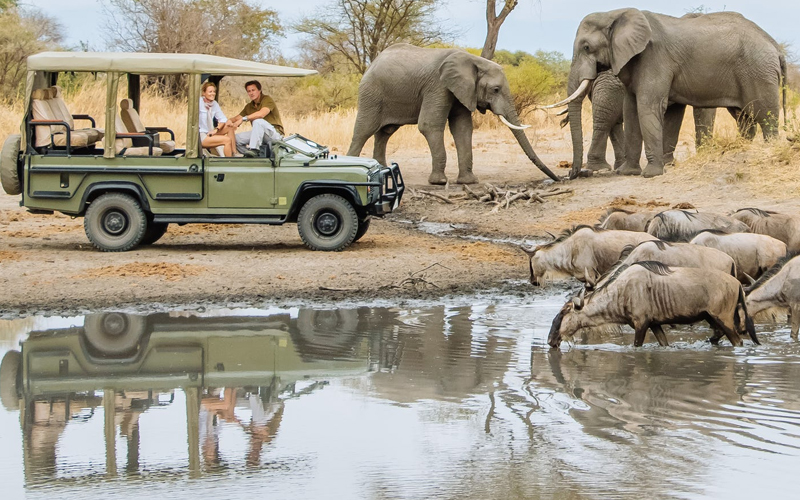Lake Manyara National Park is one of Tanzania’s most captivating safari destinations. Nestled at the base of the Great Rift Valley, this park is renowned for its diverse ecosystems, breathtaking scenery, and unique wildlife experiences. Although it is one of Tanzania’s smaller parks, Lake Manyara packs a punch when it comes to offering unforgettable adventures. In this article, we will explore what makes Lake Manyara National Park such an attractive destination for travelers.
Stunning Natural Beauty
- The Great Rift Valley: Lake Manyara National Park is located at the foot of the dramatic Great Rift Valley escarpment. This geological wonder forms a stunning backdrop to the park’s lush scenery. The escarpment rises sharply from the edge of the lake, creating a dramatic contrast between the steep cliffs and the flat, sprawling plains below. This unique landscape offers breathtaking views and excellent photo opportunities.
- Lake Manyara: The park is named after its central feature, Lake Manyara, a shallow alkaline lake that covers a significant portion of the park. The lake’s shimmering waters attract a variety of birds and other wildlife, creating a vibrant and dynamic ecosystem. During the rainy season, the lake swells, enhancing its beauty and attracting even more wildlife.
Diverse Wildlife
- Tree-Climbing Lions: One of the most famous attractions of Lake Manyara National Park is its population of tree-climbing lions. While lions typically roam on the ground, the lions in Lake Manyara have developed the unusual habit of climbing and resting in acacia trees. This rare behavior makes for a unique and exciting sighting, as you can spot these majestic predators lounging in the branches, often with their legs dangling lazily.
- Elephant Herds: The park is home to large herds of elephants, which are often seen grazing in the forested areas or cooling off in the lake. The elephants in Lake Manyara are known for their impressive size and close-knit family groups. Watching these gentle giants up close is a highlight of any visit to the park.
- Rich Birdlife: Lake Manyara National Park is a paradise for birdwatchers. The park boasts over 400 species of birds, making it one of the best places in Africa for birding. The lake’s shores are frequented by large flocks of flamingos, pelicans, storks, and herons. In addition, the park’s diverse habitats support a variety of other bird species, including kingfishers, hornbills, and eagles.
- Variety of Mammals: In addition to lions and elephants, Lake Manyara is home to a wide range of other mammals. Visitors can spot buffaloes, giraffes, zebras, hippos, and various species of antelopes. The park’s diverse ecosystems, including groundwater forests, acacia woodlands, and grassy plains, support this rich variety of wildlife.
Unique Ecosystems
- Groundwater Forest: One of the unique features of Lake Manyara National Park is its groundwater forest. This lush, evergreen forest is sustained by underground springs that provide a constant supply of water. The forest is dense and cool, offering a stark contrast to the surrounding savannah. It is home to a variety of animals, including blue monkeys, baboons, and bushbucks.
- Acacia Woodlands: The acacia woodlands in Lake Manyara are where you are most likely to spot the park’s famous tree-climbing lions. These open woodlands are also home to giraffes, elephants, and a variety of bird species. The acacia trees, with their distinctive umbrella-shaped canopies, create a picturesque landscape.
- Hot Springs: In the southern part of the park, you will find hot springs, also known as Maji Moto. These geothermal features add another layer of interest to the park’s diverse landscape. The hot springs are surrounded by grassy plains and provide a unique natural attraction.
Adventure Activities
- Game Drives: Game drives are the most popular way to explore Lake Manyara National Park. Whether you choose a morning, afternoon, or full-day drive, you will have the opportunity to see a wide variety of wildlife and experience the park’s different habitats. Expert guides enhance the experience by providing insights into the behavior and ecology of the animals you encounter.
- Night Drives: Lake Manyara is one of the few national parks in Tanzania that offers night game drives. These nocturnal adventures provide a completely different perspective, allowing you to see nocturnal animals such as bush babies, aardvarks, and leopards. The sounds and sights of the African night make this a thrilling and unforgettable experience.
- Walking Safaris: For a more intimate connection with the park’s natural environment, consider taking a walking safari. Guided by experienced rangers, walking safaris allow you to explore the park on foot, observing smaller creatures, plants, and tracks that are often missed on game drives. It’s an excellent way to learn about the park’s ecology and wildlife from a ground-level perspective.
Cultural Experiences
- Maasai Village Visits
Lake Manyara National Park is located near several Maasai communities. Visiting a Maasai village offers a fascinating glimpse into the traditional lifestyle and culture of the Maasai people. You can learn about their customs, see traditional dances, and purchase handmade crafts. These visits provide valuable cultural insights and support local communities.
Lake Manyara National Park is a hidden gem in Tanzania’s safari circuit. Its stunning natural beauty, diverse wildlife, and unique ecosystems make it an attractive destination for travelers seeking a memorable and varied safari experience. Whether you are captivated by the sight of tree-climbing lions, enchanted by the vibrant birdlife, or intrigued by the park’s lush forests and hot springs, Lake Manyara offers something for everyone. A visit to this park is sure to leave you with unforgettable memories and a deeper appreciation for Tanzania’s natural wonders.
FAQs
What is the best time to visit Lake Manyara National Park?
The best time to visit Lake Manyara is during the dry season (June to October) when wildlife is easier to spot. However, the park is also beautiful during the wet season (November to May) when the landscape is lush, and birdlife is abundant.
Can you see the Great Migration in Lake Manyara National Park?
No, the Great Migration primarily occurs in the Serengeti and Maasai Mara ecosystems. However, Lake Manyara offers its unique wildlife experiences, including the famous tree-climbing lions.
How long should you spend in Lake Manyara National Park?
A stay of one to two days is sufficient to explore the main attractions of Lake Manyara National Park. This allows for game drives, birdwatching, and possibly a night drive or walking safari.
Is Lake Manyara National Park family-friendly?
Yes, Lake Manyara National Park is family-friendly. The park’s diverse wildlife and activities like game drives and cultural visits make it an excellent destination for families with children.
What should you pack for a visit to Lake Manyara National Park?
Pack light, breathable clothing for warm days and a few layers for cooler mornings and evenings. Essentials include sunscreen, a hat, insect repellent, binoculars, a good camera, and comfortable walking shoes.
For immersive experiences around Lake Duluti and Lake Manyara, as well as cultural tours in Mto wa Mbu, explore the following topics on our page:
Discover detailed insights and tips for a memorable adventure tailored to your interests and preferences.


